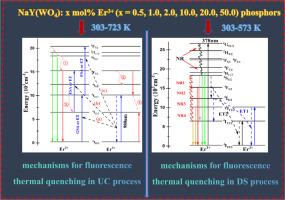NaY(WO4)2: Er3+荧光粉的浓度依赖性发光热猝灭行为
IF 5.7
3区 材料科学
Q2 MATERIALS SCIENCE, MULTIDISCIPLINARY
引用次数: 0
摘要
发光热猝灭是影响发光性能的关键因素,已被广泛研究。然而,对于浓度效应对发光热猝灭的影响研究很少。本工作旨在通过实验揭示发光热猝灭的浓度依赖性。为此,NaY(1-x)Erx(WO4)2 (x = 0.005, 0.01, 0.02, 0.1, 0.20。x射线衍射(XRD)表征得到了纯相NaY(WO4)2晶体粉末。在378 nm和980 nm激发下,实验观察了2H11/2、4S3/2、4F9/2、4I11/2、4I13/2到4I15/2的发光强度随温度的变化,发现Er3+浓度对发光热猝灭有较大影响。根据光谱测量,推导了浓度依赖性发光热猝灭的可能机理。发现样品温度主要改变了非辐射弛豫速率,从而导致能量传递方式的变化。因此,对浓度相关的热猝灭的研究将揭示掺杂浓度和温度对上转换(UC)和降移(DS)发光的影响。本文章由计算机程序翻译,如有差异,请以英文原文为准。

Concentration-dependent luminescence thermal quenching behavior in NaY(WO4)2: Er3+ phosphors
Luminescent thermal quenching is a crucial factor affecting luminescent performance and has been widely studied. However, very less efforts have been paid to the concentration effect on luminescence thermal quenching. This work aims to experimentally reveal the concentration dependence of luminescent thermal quenching. To this end, NaY(1-x)Erx(WO4)2 (x = 0.005, 0.01, 0.02, 0.1, 0.20., 0.5) phosphors were synthesized and the X-ray diffraction (XRD) characterization reveals that pure-phase NaY(WO4)2 crystalline powders were obtained. The temperature-dependent luminescence intensities for the transitions from 2H11/2, 4S3/2, 4F9/2, 4I11/2, 4I13/2 to 4I15/2 were experimentally observed upon 378 and 980 nm excitation, and it was found that the Er3+ concentration affects the luminescence thermal quenching greatly. The possible mechanisms for the concentration-dependent luminescence thermal quenching were deduced based on the spectral measurements. It was found that the sample temperature mainly changes the non-radiative relaxation rates, thus further resulting in the changes of energy transfer approaches. Thus, the investigations of concentration-dependent thermal quenching will shed light on the impacts of doping concentrations and temperatures on up-conversion (UC) and downshifting (DS) luminescence.
求助全文
通过发布文献求助,成功后即可免费获取论文全文。
去求助
来源期刊

Materials Research Bulletin
工程技术-材料科学:综合
CiteScore
9.80
自引率
5.60%
发文量
372
审稿时长
42 days
期刊介绍:
Materials Research Bulletin is an international journal reporting high-impact research on processing-structure-property relationships in functional materials and nanomaterials with interesting electronic, magnetic, optical, thermal, mechanical or catalytic properties. Papers purely on thermodynamics or theoretical calculations (e.g., density functional theory) do not fall within the scope of the journal unless they also demonstrate a clear link to physical properties. Topics covered include functional materials (e.g., dielectrics, pyroelectrics, piezoelectrics, ferroelectrics, relaxors, thermoelectrics, etc.); electrochemistry and solid-state ionics (e.g., photovoltaics, batteries, sensors, and fuel cells); nanomaterials, graphene, and nanocomposites; luminescence and photocatalysis; crystal-structure and defect-structure analysis; novel electronics; non-crystalline solids; flexible electronics; protein-material interactions; and polymeric ion-exchange membranes.
 求助内容:
求助内容: 应助结果提醒方式:
应助结果提醒方式:


